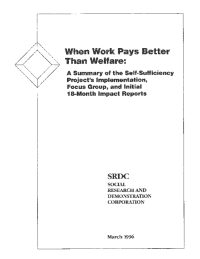When Work Pays Better Than Welfare
A Summary of the Self-Sufficiency Project's Implementation, Focus Group, and Initial 18-Month Impact Reports
These pages summarize the accomplishments to date of the Self-Sufficiency Project (SSP), a research and demonstration project conceived and funded by Human Resources Development Canada (HRDC) and managed by the Social Research and Demonstration Corporation (SRDC). SSP seeks a solution to two urgent and related social problems: the increasing poverty and welfare dependence of single-parent families. Unfortunately, efforts to alleviate one of these conditions have frequently exacerbated the other: When welfare benefits are raised in order to decrease poverty, dependence often grows. But when benefits are lowered in order to minimize dependence, families who remain dependent on public assistance fall deeper into poverty.
This dilemma is reflected in the experience of welfare-dependent families. Because many single-parent welfare recipients have low levels of education and limited work experience, starting wages are often less than welfare payments. Thus, it is not uncommon for single parents on welfare to confront a stark choice: continued dependence on welfare or a lower income in the work world, at least until wages rise with increasing experience and skills.
SSP provides a third option. It offers to supplement the earnings of singleparent Income Assistance (welfare) recipients who have received benefits for at least one year, as long as they leave the Income Assistance rolls and take a full time job (at least 30 hours per week). The supplement is time-limited: Recipients who find a job within one year of being offered the supplement can receive supplement payments for up to three years. It is also generous: SSP's earnings supplement effectively doubles the income of workers who take jobs paying as much as $8.00 an hour. Thus, SSP solves a common problem for long-term Income Assistance recipients who go to work: low starting wages.
SSP employs a research design of exceptional rigour. Half of those who agreed to be part of the study were chosen at random to be eligible for the SSP earnings supplement, while the other half, similar in every way to the SSP-eligible group, became a "control" group, whose subsequent behaviour reveals what would have happened to the SSP-eligible group in the absence of SSP.
Over the last few months, SRDC has published the first three full-length products of this ongoing research effort. This document reviews the major findings thus far, which suggest that an earnings supplement program can be successfully implemented, that many long-term welfare recipients want and are able to find the full-time employment that qualifies them to receive earnings supplements, and that such a program can significantly increase employment and earnings, and decrease welfare dependence, in the first 18 months of program participation. The early story of SSP is thus quite promising. Future research will determine whether SSP fulfills this promise by continuing to make a difference in the lives of participants, especially in the period after earnings supplementation ends.






